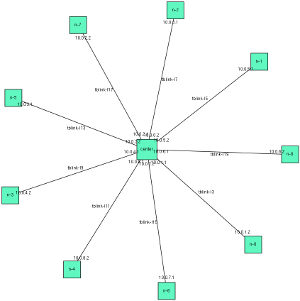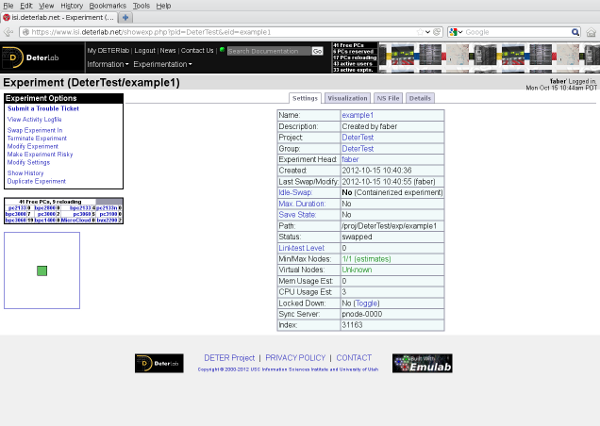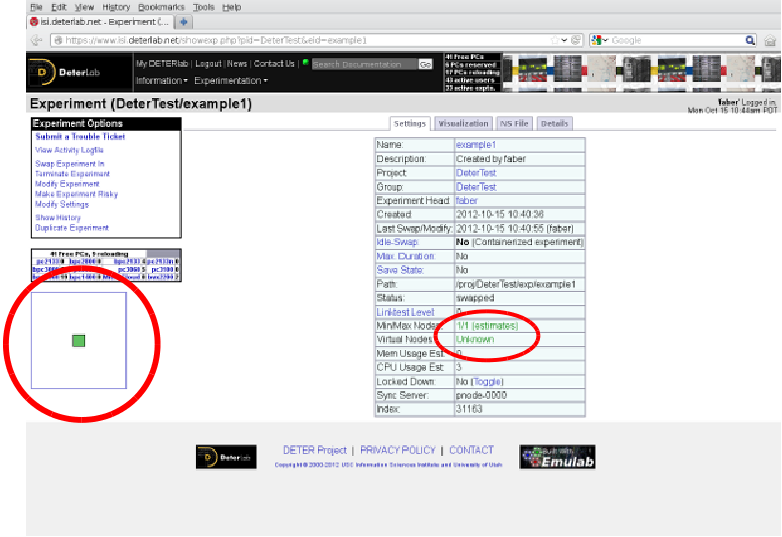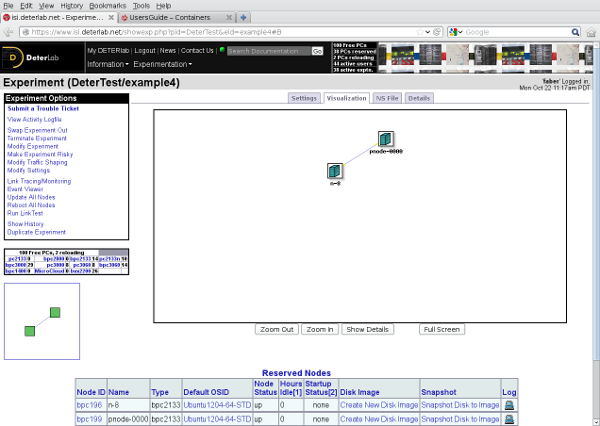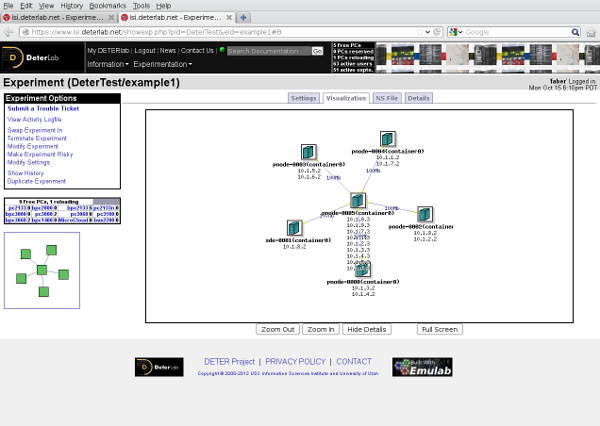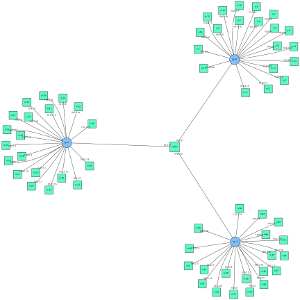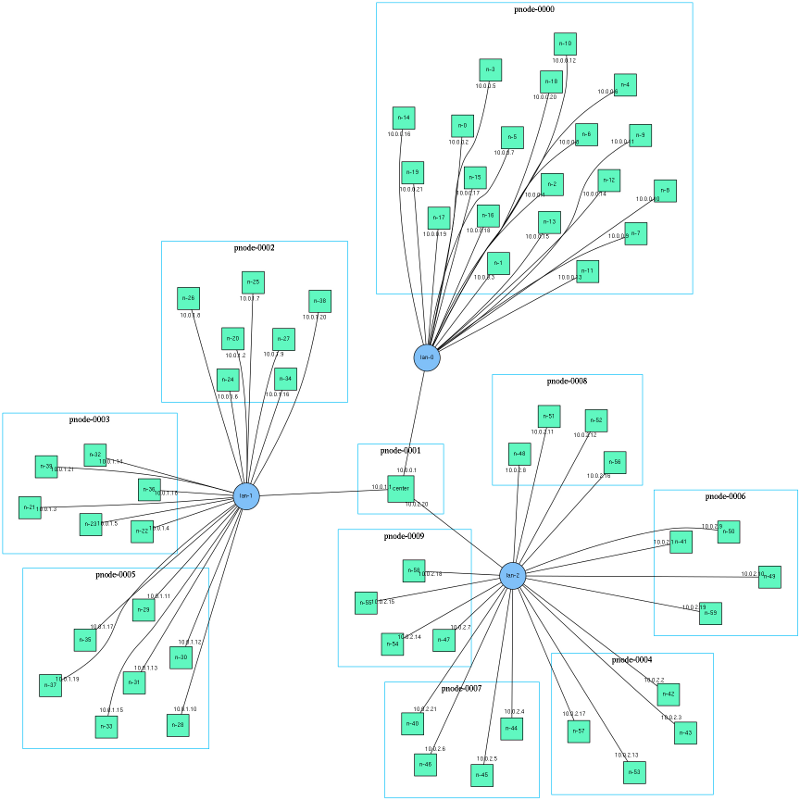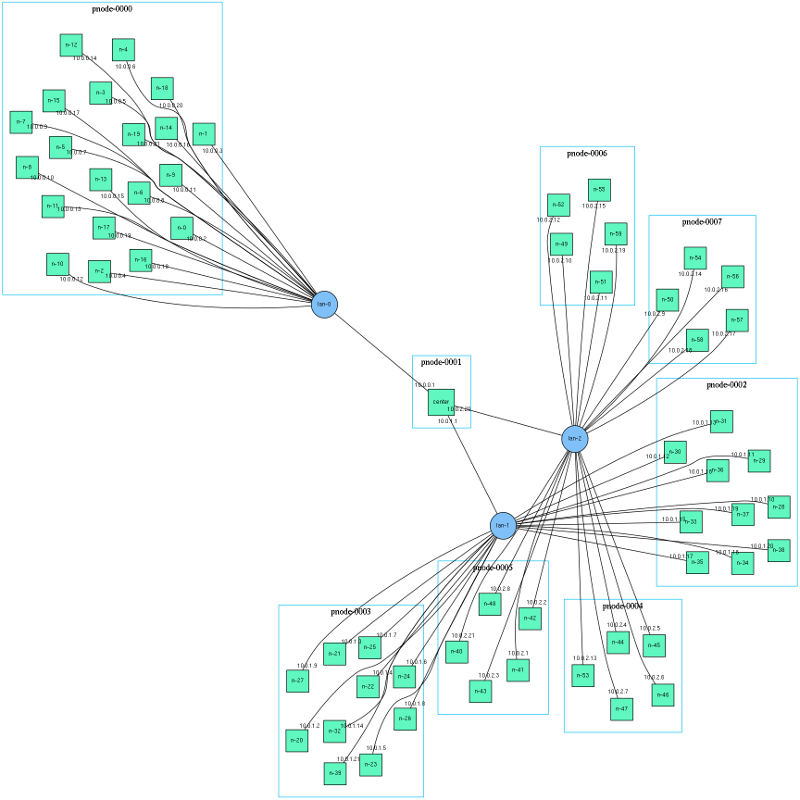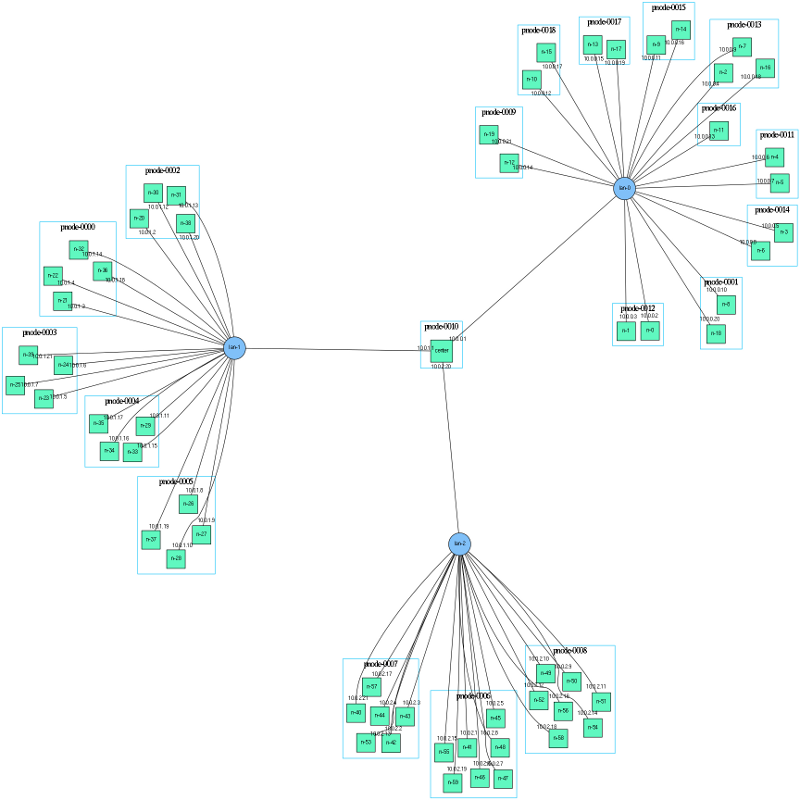| Version 39 (modified by , 10 years ago) (diff) |
|---|
Table of Contents
Users Guide / Tutorial
This document describes the workflow and commands to create an use a containerized experiment. We work through a couple examples showing the major features of the containers system. Detailed descriptions of the commands and configuration files are in the reference section.
A Containerized Experiment
This example will walk through creating an experimental topology starting with how to describe a topology through building and using the containerized experiment.
Describing the Topology
Our first example is a star topology. We create a central node and connect 9 other nodes to it. It looks like this:
For this example we will use the standard DETER topology descriptions. If you have never used DETER, you should work through the DETER tutorial first. The container system is largely compatible with the physical DETER interface.
A DETER-compatible ns2 description of that topology is attached to this page. You can download it to users.isi.deterlab.net and follow along. It is a simple loop, along with the standard DETER boilerplate. This file can be used to create a 10-node (9 satellites and one central node) physical experiment on DETER, although there are not many physical nodes on DETER with 10 interfaces (one interface for control traffic).
source tb_compat.tcl
set ns [new Simulator]
# Create the center node (named by its variable name)
set center [$ns node]
# Connect 9 satellites
for { set i 0} { $i < 9 } { incr i} {
# Create node n-1 (tcl n($i) becomes n-$i in the experiment)
set n($i) [$ns node]
# Connect center to $n($i)
ns duplex-link $center $n($i) 100Mb 10ms DropTail
}
# Creation boilerplate
$ns rtptoto Static
$ns run
With the detailed experiment description in front of us, we see a few more details. The central node is named "center" and each satellite is names "n-0", "n-1"... through "n-8". Each connection is a 100 Mb/s link with a 10ms delay. The round trip time from n-0 to center will be 20 ms and from n-0 to n-1 will be 40 ms.
Creating The Containerized Experiment
The container system will build the containerized experiment on top of a DETER physical experiment. We do this by running a command from the shell on users.isi.deterlab.net. With a copy of the example topology in your home directory named example1.tcl, the following command will create the containerized experiment:
$ /share/containers/containerize.py DeterTest example1 ~/example1.tcl
The first two parameters are the project and experiment name to hold the DETER experiment. This invocation will create an experiment called experiment1 in the DeterTest project. As with any DETER experiment, you must be a member of the project with appropriate rights to create an experiment in it. containerize.py expecte there to be no experiment with that name, and it will fail if one exists. To remove an experiment you can terminate it through the web interface or use the endexp command. Terminating an experiment is more final than swapping one out, so be sure that you want to replace the old experiment. You can also resolve the conflict by renaming your new containerized experiment.
The last parameter is the file containing the topology. That can be an ns2 file, like our example, or a topdl description. An ns2 description must end in .tcl or .ns.
With these default parameters containerize.py will put each node into an Openvz container with at most 10 containers per physical node.
Running the command above on users -- make sure you run it with a project you are a member of -- yields:
users:~$ /share/containers/containerize.py DeterTest example1 ~/example1.tcl Containerized experiment DeterTest/example1 successfully created! Access it via http://www.isi.deterlab.net//showexp.php3?pid=DeterTest&eid=example1
Now we can see what a containerized experiment looks like.
The Contents of a Containerized Experiment
If you follow the link to that containerize.py prints, you will see a standard DETER experiment page that looks like this:
This may surprise you. In particular, you may be surprised to see that DETER thinks the experiment has only one node:
The containers system has rewritten the description file and stored additional information in the experiment's per-experiment directory that will be used to create the 10 node experiment inside the single-node DETER experiment. If you look at the ns file DETER has stored (the NS file tab on the experiment page), you will see this file:
set ns [new Simulator]
source tb_compat.tcl
tb-make-soft-vtype container0 {pc2133 bpc2133 MicroCloud}
set pnode(0000) [$ns node]
tb-set-node-os ${pnode(0000)} CentOS6-64-openvz
tb-set-hardware ${pnode(0000)} container0
tb-set-node-startcmd ${pnode(0000)} "sudo /share/containers/setup/hv/bootstrap /proj/DeterTest/exp/example1/containers/site.conf >& /tmp/container.log"
tb-set-node-failure-action ${pnode(0000)} "nonfatal"
$ns rtproto Static
$ns run
That looks nothing like the file we gave to containerize.py, but it does show us a little about what the containers system has done. The single physical node (pnode(0000)) will run the CentOS6-64-openvz image and run on a few kinds of node. On startup pnode(0000) will execute a command from the same /share/containers directory that containerize.py ran from using data in the per-experiment directory /proj/DeterTest/exp/example1/containers/site.conf.
There is a separate /proj/DeterTest/exp/example1/containers/ directory for each experiment. The path element after /proj is replaced with the project under which the experiment was created, DeterTest in this example, and the element after exp is the experiment name, example1 in this case. These directories are created for all DETER experiments. The containers sub-directory holds information specific to a containerized experiment.
There are a few useful bits of data in that per-experiment containers directory that we can look at. To avoid the long pathname we will talk about files in containers/, the subdirectory.
First, a copy of the topology that we gave to containerize.py is available in /proj/DeterTest/exp/example1/containers/experiment.tcl. If the experiment is created from a topdl file, the filename will be containers/experiment.tcl.
A simple vizualization of the experiment is in containers/visualization.png. This is annotated with node and network names as well as interface IP addresses. The topology depiction above is an example. A larger version is also attached.
The containers/hosts file is a copy of the IP to hostname mapping found on each virtual machine in the topology. It can be useful in converting IP addresses back to names. It is installed in /etc/hosts or the equivalent on each machine.
The two files /var/containers/pid and /var/containers/eid contain the project name and experiment name. Scripts can make use of these.
The rest of the contents of that directory are primarily used internally by the implementation, but a more detailed listing is in the reference guide.
At this point, as with any DETER experiment, the topology does not have any resources attached. To get the resources, swap the experiment in from the web interface or using the swapexp command.
Using the Experiment
Swapin is just the start for a containerized experiment. Once the DETER web interface reports that the experiment has finished its swap-in, the programs that convert the physical topology into the virtual topology have just started to run. At the moment, the containers system does not have a good mechanism for notifying the world that the virtual topology has been successfully created. We are working on resolving this shortcoming, and in the long run we expect MAGI agents to provide this functionality. Until then, you can ping or try to ssh to individual nodes in the experiment, or use the workaround we sugeest below.
Once the containerized elements have all started, the nodes are available as if they were physical nodes. For example, we can access node n-0 of the experiment we swapped in by:
$ ssh n-0.example1.detertest
Be sure that you replace example1 with the experiment name you passed to containerize.py and DeterTest with the project you created the experiment under. This is a DNS name, so it is case-insensitive.
When the ssh succeeds you will have access to an Ubuntu 10.04 32-bit node with the same directories mounted as in a physical deter experiment. Your home directory will be mounted, so your ssh keys will work for accessing the machine.
To confirm that the containerized experiment is working as we expect, we can ping other nodes, using the same node naming conventions as physical DETER experiments. Containerized nodes access the control net as well, so access them using the same node naming conventions.
Here is a ping from n-0 to center and n-1.
n-0:~$ ping -c 3 center PING center-tblink-l21 (10.0.0.2) 56(84) bytes of data. 64 bytes from center-tblink-l21 (10.0.0.2): icmp_seq=1 ttl=64 time=20.4 ms 64 bytes from center-tblink-l21 (10.0.0.2): icmp_seq=2 ttl=64 time=20.0 ms 64 bytes from center-tblink-l21 (10.0.0.2): icmp_seq=3 ttl=64 time=20.0 ms --- center-tblink-l21 ping statistics --- 3 packets transmitted, 3 received, 0% packet loss, time 2002ms rtt min/avg/max/mdev = 20.052/20.184/20.445/0.184 ms n-0:~$ ping -c 3 n-1 PING n-1-tblink-l5 (10.0.6.1) 56(84) bytes of data. 64 bytes from n-1-tblink-l5 (10.0.6.1): icmp_seq=1 ttl=64 time=40.7 ms 64 bytes from n-1-tblink-l5 (10.0.6.1): icmp_seq=2 ttl=64 time=40.0 ms 64 bytes from n-1-tblink-l5 (10.0.6.1): icmp_seq=3 ttl=64 time=40.0 ms --- n-1-tblink-l5 ping statistics --- 3 packets transmitted, 3 received, 0% packet loss, time 2003ms rtt min/avg/max/mdev = 40.094/40.318/40.764/0.355 ms
The nodes have the expected round trip times.
At this point you can load and run software and generally experiment normally.
Start Commands
DETER provides a facility to run a command when the experiment starts, called start commands. A containerized experiment offers a similar facility with a few differences:
- The start commands are not coordinated across nodes. In DETER the start commands all execute when the last node has reported to the testbed that it has completed booting. In a containerized experiment, the startcommands run when the containerized node has come up.
- Logs from the start command are in
/var/containers/log/start_command.outand/var/containers/log/start_command.err. This is true on embedded pnodes as well. - Start commands have to be shorter than in DETER because the container system is also using the facility.
- The event system cannot be used to replay the start command.
While start commands that make use of shell syntax for multiple commands and simple file redirection (e.g, > or <) can work, errors parsing redirection or other shell commands will cause the start command to fail silently. Because of this, and because containerized experiments cannot have as long a start command string, we recommend that if you are doing anything more complex than calling a single program, create a simple script and run the script from the per-expriment directory or your home directory. This makes it more likely that the log files created by containers will have useful debugging information.
We strongly recommend removing all shell redirection characters from the text of your start command. Redirecting I/O in the text of the start command may fail silently.
Start commands give offer a simple workaround for detecting that all nodes in an experiment have started.
#!/bin/sh STARTDIR="/proj/"`cat /var/containers/pid`"/exp/"`cat /var/containers/eid`"/startup" mkdir $STARTDIR date > $STARTDIR/`hostname`
Making the script above the start command of all nodes will put the time that each local container came up in the the startup directory under the per-experiment directories. For example, n-0.example1.DeterTest will create /proj/DeterTest/exp/example1/startup/n-0. An experimenter can monitor that directory on users and know which nodes are up.
Releasing Resources
As with a physical DETER experiment, you release resources by swapping the experiment out using the web interface or the swapexp command. If you are using the startcommand workaround to detect startup, clear the startup directory when you swap the experiment out.
Advanced Usage
The previous section showed how to create an experiment using only openvz containers packed 10 to a machine. This section shows how to change those parameters.
Using Other Container Types
To change the container type that containerize.py assigns to nodes, use the --default-container option. Valid choices follow the kinds of containers DETER suports. Specifically:
| Parameter | Container |
embedded_pnode | Physical Node |
qemu | Qemu VM |
openvz | Openvz Container |
process | ViewOS process |
We can try this on our example topology:
users:~$ /share/containers/containerize.py --default-container qemu DeterTest example2 ~/example1.tcl Requested a QEMU node with more than 7 experimental interfaces. Qemu nodes can only support 7 experimental interfaces.
The good news is that the container system is using qemu containers to build our experiment. Unfortunately qemu containers only support 7 experimental interfaces, an internal limit on the number of interfaces the virtual hardware supports. A version of the topology with fewer satellites will containerize without error.
$ /share/containers/containerize.py --default-container qemu DeterTest example2 ~/example2.tcl Containerized experiment DeterTest/example2 successfully created! Access it via http://www.isi.deterlab.net//showexp.php3?pid=DeterTest&eid=example2
The qemu experiment looks much like the openvz experiment above, at this small scale. Qemu nodes more completely emulate hardware and the kernels are independent, unlike openvz containers. For example, a program can load kernel modules in a qemu VM, which it cannot do in an openvz container. The qemu containers load the Ubuntu 12.04 (32 bit) distribution by default.
We can also swap in the experiment using ViewOS processes, but processes cannot be manipulated from outside. They are too lightweight to allow an ssh login, though they will run a start command.
Mixing Containers
Mixing containers requires the experimenter to assign container types in their topology description. This is done by attaching an attribute to nodes. The attribute is named containers:node_type it takes the same values as the --default-container parameter to containerize.py. If the experiment definition is in topdl the attribute can be attached using the standard topdl routines. Attaching the attribute in ns2 is done using the DETER tb-add-node-attribute command.
tb-add-node-attribute $node containers:node_type openvz
That command in an ns2 topology description will set node to be placed in an openvz container. Using this feature, we can modify our first topology to consist of qemu nodes and a single process container in the center. Process nodes can have unlimited interfaces, but we cannot log into them. The new topology file looks like this:
source tb_compat.tcl
set ns [new Simulator]
# Create the center node (named by its variable name)
set center [$ns node]
# The center node is a process
tb-add-node-attribute $center containers:node_type process
# Connect 9 satellites
for { set i 0} { $i < 9 } { incr i} {
# Create node n-1 (tcl n($i) becomes n-$i in the experiment)
set n($i) [$ns node]
# Satellites are qemu nodes
tb-add-node-attribute $n($i) containers:node_type qemu
# Connect center to $n($i)
ns duplex-link $center $n($i) 100Mb 10ms DropTail
}
# Creation boilerplate
$ns rtptoto Static
$ns run
Because we have explicitly set the container_node_type of each node, the --default-container parameter to containerize.py does nothing. We can create this experiment using:
users:~$ /share/containers/containerize.py DeterTest example3 ~/example3.tcl Containerized experiment DeterTest/example3 successfully created! Access it via http://www.isi.deterlab.net//showexp.php3?pid=DeterTest&eid=example3
When we swap it in, the experiment will have 10 satellite containers in qemu VMs and a central process that only forwards packets. Again, you cannot log in to a process container, but you can use the qemu nodes as though they were physical machines.
Another interesting mixture of containers is to put a physical node into the mix. Here is a modified version of our mixed topology that places the n-8 satellite on a physical computer, by setting its containers:node_type to embedded_pnode.
After creating that experiment:
users:~$ /share/containers/containerize.py DeterTest example4 ~/example4.tcl Containerized experiment DeterTest/example4 successfully created! Access it via http://www.isi.deterlab.net//showexp.php3?pid=DeterTest&eid=example4
We can call up the DETER experiment page and look at the visualization tab:
The physical node n-8 shows up in the DETER visualization, and otherwise acts as a physical node that is in a 10-node topology. This experiment uses three different container types: physical nodes, ViewOS processes, and Qemu VMs.
Setting Openvz Parameters
An advantage of openvz nodes is that the OS flavor and CPU bit-width can be set across experiments and per-node. Similarly the size of the disk allocated to each node can be set.
Openvz uses templates to look like various linux installations. The choices of Linux distribution that openvz supports are:
| Template | Distribution | Bit-width |
| centos-6-x86 | CentOS 6 | 32 bit |
| centos-6-x86_64 | CentOS 6 | 64 bit |
| ubuntu-10.04-x86 | Ubuntu 10.04 LTS | 32 bit |
| ubuntu-10.04-x86_64 | Ubuntu 10.04 LTS | 64 bit |
| ubuntu-12.04-x86 | Ubuntu 12.04 LTS | 32 bit |
| ubuntu-12.04-x86_64 | Ubuntu 12.04 LTS | 64 bit |
By default the ubuntu-10.04-x86 template is used.
To set a template across an entire topology, give --openvz-template and the template name from the list above. Invoking containerize.py on our original example as below will instantiate the experiment under 64-bit Ubuntu 12.04:
users:~$ /share/containers/containerize.py --openvz-template ubuntu-12.04-x86_64 DeterTest example1 ~/example1.tcl Containerized experiment DeterTest/example1 successfully created! Access it via http://www.isi.deterlab.net//showexp.php3?pid=DeterTest&eid=example1
We can set the size of the file system of containers in the experiment using --openvz-diskspace. The value of the parameter is determined by the suffix:
| Suffix | Value |
| G | Gigabytes |
| M | Megabytes |
The default openvz file system size is 2GB.
The most practical suffix for DETER nodes is "G":
users:~$ /share/containers/containerize.py --openvz-diskspace 15G DeterTest example1 ~/example1.tcl Containerized experiment DeterTest/example1 successfully created! Access it via http://www.isi.deterlab.net//showexp.php3?pid=DeterTest&eid=example1
Each of these parameters can be set on individual nodes using attributes. The attribute to set a template on a node is containers:openvz_template and the attribute to set the disk space is containers:openvz_diskspace. This example shows setting these openvz parameters per node:
source tb_compat.tcl
set ns [new Simulator]
# Create the center node (named by its variable name)
set center [$ns node]
# The center node is a process
tb-add-node-attribute $center containers:node_type process
tb-add-node-attribute $center containers:openvz_template ubuntu-12.04-x86_64
# Connect 9 satellites
for { set i 0} { $i < 9 } { incr i} {
# Create node n-1 (tcl n($i) becomes n-$i in the experiment)
set n($i) [$ns node]
# Set satellite disk sizes to be 20 GB
tb-add-node-attribute $n($i) containers:openvz_diskspace 20G
# Connect center to $n($i)
ns duplex-link $center $n($i) 100Mb 10ms DropTail
}
# Creation boilerplate
$ns rtptoto Static
$ns run
The center node will run Ubuntu 12.04 64 bit and the satellites will have 20GB file systems.
Setting Qemu Parameters
The containers system has a more limited ability to set qemu parameters. Right now a custom image can be loaded using the containers::qemu_url attribute and the architecture of the qemu VM can be chosen using containers:qemu_arch. Valid qemu architectures are:
| Param | Meaning |
| i386 | 32 bit Intel |
| x86_64 | 64-bit Intel |
The image URL must be reachable from inside DETER. The image must be a qcow2 image, optionally bzip2ed. Facilities to snapshot and store such images are in development.
If you are using a qemu image that is not booting into containers, make sure grub is properly configured
Qemu images also mount users home directories as DETER physical nodes do. In order to do this scalably the Qemu VMs mount the users' directories from the physical node. The DETER infrastrcuture cannot support exporting users' directories to thousands of containers.
However, a Qemu VM can only mount a few tens of user directories this way. The limit is 23 user directories (24 in experiments that are not instantiated in a group). Many projects have more than 23 users, but in practice only a few experimenters need access to the containers.
To tell the container systems which user to mount, use the --qemu-prefer-users option to containerize.py. That option takes a comma-separated list of usernames (no spaces). When the Qemu nodes will always mount those users' home directories. Others will be mounted if there is room.
For example:
users:~$ /share/containers/containerize.py --qemu-prefer-users=faber,jjh DeterTest example4 ~/example4.tcl
Will make sure that users faber and jjh have their home directories mounted in any Qemu containers.
Changing The Packing Factor
The containerize.py program is deciding how many virtual nodes to put on each physical machine. Because we have been using roughly the same number of nodes as the default packing target (10 nodes per machine) all the examples have fit on a single machine. If we change the packing factor, using the --packing parameter to containerize.py we can put fewer nodes on each machine. For example:
users:~$ /share/containers/containerize.py --packing 2 DeterTest example1 ~/example1.tcl Containerized experiment DeterTest/example1 successfully created! Access it via http://www.isi.deterlab.net//showexp.php3?pid=DeterTest&eid=example1
Calls containerize.py on our original topology with a low packing factor. The result is the same nodes spread across more physical machines, as we can see from the DETER web interface (visualization tab):
You will want to balance how many physical machines you use against how precisely you want to mimic them.
User Packing
An experimenter can specify their own packing using the containers:partition attribute; it is integer-valued. All nodes with the smae partition are allocated to the same machine. If nodes have that attribute attached to them, containers.py will assume that they all have been paritioned and use those. Nodes without a partition assigned are taken to be embedded_pnodes.
More Sophisticated Packing: Multiple Passes
The previous examples have all treated packing containers onto physical machines as a single step process with a single parameter - the packing factor. In fact, we can divide containers into sets and pack each set independently using different parameters. For example in an experiment with many containers dedicated only to forwarding packets and a few to modeling servers, we could create two sets and pack the forwarders tightly (a high packing factor) and the servers loosely.
In return for the greater control on packing, there is a price. When a set of containers is packed, the containers system takes into account both the nodes to be packed and their interconnections. When subsets of containers are packed, the system cannot consider the interconnections between subsets. In some cases, the packing of subsets can lead to a DETER experiment that cannot be created successfully. This danger is mitigated by the fact that containers that are packed together are often related in ways that limit the number of connections between that set and another.
To explore packing, we need a larger topology:
source tb_compat.tcl
set ns [new Simulator]
set center [$ns node]
tb-add-node-attribute $center "containers:PartitionPass" 0
for { set i 0} { $i < 3 } { incr i} {
set lanlist $center
for { set j 0 } { $j < 20} { incr j } {
set idx [expr $i * 20 + $j]
set n($idx) [$ns node]
tb-add-node-attribute $n($idx) "containers:PartitionPass" [expr $i + 1]
lappend lanlist $n($idx)
}
set lan($i) [$ns make-lan [join $lanlist " "] 100Mb 0]
}
# Creation boilerplate
$ns rtptoto Static
$ns run
This creates 3 20-node subnetworks attached to a single central router. It looks like this:
Each node in the topology is assigned a containers::PackingPass attribute that groups them into subsets. The conatiners:PackingPass attribute must be assigned an integer value. The nodes in each packing pass are considered together when packing. Each pass can be assigned different parameters. The passes are carried out in order, though that is rarely important.
Our topology assigns center to pass 0, the nodes on lan-0 (the tcl variable lan(0)) to pass 1, those on lan-1 to pass 2 and those on lan-2 to pass 3. We will use the --pass-pack parameter to specify the packing factor for each pass. Each packing factor specification looks like pass:factor where pass and factor are both integers. We can specify more than one, separated by commas, or specify --pass-pack more than once.
For example, we can pack the experiment using the following factors:
| Pass | Packing Factor |
| 0 | 1 |
| 1 | 20 |
| 2 | 10 |
| 3 | 5 |
By issuing:
users:~$ /share/containers/containerize.py --pass-pack 0:1,1:20,2:10,3:5 DeterTest example6 ~/example6.tcl Containerized experiment DeterTest/example6 successfully created! Access it via http://www.isi.deterlab.net//showexp.php3?pid=DeterTest&eid=example6
We can view the packing by using container_image.py to generate a visualization that includes the partitions:
users:~$ /share/containers/container_image.py --experiment DeterTest/example6 --partitions --out ~/example6.png
The output shows the topology with boxes drawn around the containers that share a physical node:
That partitioning is surprising in that lan-1 is split into 3 partitions of 6 & 7 nodes rather than 2 parititons of 10. Similarly lan-2 is split into 5 groups of 4 rather than 4 groups of 5. The packing system is built on the metis graph paritioning software. Metis takes a graph and a number of partitions and finds the most balanced partitioning that has roughly equal node counts in each partition as well as low inter-partition communication costs. The containers system calls metis with increasing numbers of paritions until a partitioning is found that meets the packing factor limits.
When the system attempts to pack lan-1 into 2 partitions, metis balances the node counts and the communications costs to produce a partition with 9 containers in one machine and 11 on the other. That partitioning does not meet the 10 node limit, so it tries again with 3 partitions and succeeds.
There are two ways to fit our topology onto fewer nodes. The first is to put slightly more slop into the packing factors:
| Pass | Packing Factor |
| 0 | 1 |
| 1 | 20 |
| 2 | 11 |
| 3 | 6 |
users:~$ /share/containers/containerize.py --pass-pack 0:1,1:20,2:11,3:6 DeterTest example6 ~/example6.tcl Containerized experiment DeterTest/example6 successfully created! Access it via http://www.isi.deterlab.net//showexp.php3?pid=DeterTest&eid=example6
These parameters result in this packing, which fits in fewer nodes, but has the slight imbalances of splitting lan-1 into 9 and 11 containers and lan-2 into 4,5,and 6 container partitions. Again, this asymmetry is an attempt to consider the internode networking costs.
If the packing constraints are exact - 11 containers on lan-1 is unacceptable - a second choice is to use the --nodes-only option. This sets the cost of each arc in the graph to 0. Metis ignores such arcs altogether, so the partitions are completely even. This may cause trouble in more complex network topologies.
The result of (original packing factors and --nodes-only)
users:~$ /share/containers/containerize.py --nodes-only --pass-pack 0:1,1:20,2:10,3:5 DeterTest example6 ~/example6.tcl Containerized experiment DeterTest/example6 successfully created! Access it via http://www.isi.deterlab.net//showexp.php3?pid=DeterTest&eid=example6
is
which has symmetric partitions.
Sometimes it is more intuitive to think in terms of the number of machines that will be used to hold containers. The --size and -pass-size options let users express that. The --size=expsize option uses expsize machines to hold the whole experiment. If multiple passes are made, each is put into expsize physical machines. The --size option takes precedence over --packing.
Per-pass sizing can be done using --pass-size which uses the same syntax as --pass-pack. So:
users:~$ /share/containers/containerize.py --pass-size 0:1,1:1,2:2,3:4 DeterTest example6 ~/example6.tcl Containerized experiment DeterTest/example6 successfully created! Access it via http://www.isi.deterlab.net//showexp.php3?pid=DeterTest&eid=example6
packs pass 0 into 1 physical machine, pass 1 into 1 physical machine, pass 2 into 2 physical machines and pass 3 into 4 physcial machines. The result looks like:
Partitions have different numbers of containers in them because metis is considering network constraints as well. As with using packing, adding --nodes-only restores symmetry:
The --pass-pack option is a per-pass generalization of the --packing option. The options that can be specified per-pass are:
| Single-pass | Per-Pass | Per-Pass Format | Per-Pass Example |
--packing | --pass-pack | pass:packing (comma-separated) | --pass-pack 0:1,1:20,2:11,3:6 |
--size | --pass-size | pass:size (comma-separated) | --pass-size 0:1,1:1,2:2,3:4 |
--pnode-types | --pass-pnodes | pass:pnode[,pnode...] (semicolon separated) | --pass-pnodes 0:MicroCloud;1:bpc2133,pc2133 |
--nodes-only | --pass-nodes-only | pass (comma-separated) | --pass-nodes-only 1,3,5 |
The single-pass version sets a default so this invocation on our 4 pass topology:
users:~$ /share/containers/containerize.py --packing 5 --pass-pack 0:1,1:20 DeterTest example6 ~/example6.tcl Containerized experiment DeterTest/example6 successfully created! Access it via http://www.isi.deterlab.net//showexp.php3?pid=DeterTest&eid=example6
will pack pass 0 with a factor of 1, pass 1 with a factor of 20 and passes 2 and 3 with factor 5.
Similarly:
users:~$ /share/containers/containerize.py --pass-pack 0:1,1:20,2:10,3:5 --pass-pnodes '0:pc2133,bpc2133;1:MicroCloud' DeterTest example6 ~/example6.tcl Containerized experiment DeterTest/example6 successfully created! Access it via http://www.isi.deterlab.net//showexp.php3?pid=DeterTest&eid=example6
will allocate either bpc2133 or pc2133 nodes to containers assigned by pass 0 and Microcloud physical nodes to the containers partitioned in pass 1. The rest will be allocated as the site configuration specifies. The single quotes around the --pass-pnodes option protects the semi-colon from the shell. Another choice is to specify the command as:
users:~$ /share/containers/containerize.py --pass-pack 0:1,1:20,2:10,3:5 --pass-pnodes 0:pc2133,bpc2133 --pass-pnodes 1:MicroCloud DeterTest example6 ~/example6.tcl
That formulation avoids the quotes by avoiding the semicolon. All the per-pass options may be specified multiple times on the command line.
One can mix and match sizes and packing factors. This invocation:
/share/containers/containerize.py --pass-size 1:10 --pass-pack 2:5,3:10 DeterTest example6 ~/example6.tcl Containerized experiment DeterTest/example6 successfully created! Access it via http://www.isi.deterlab.net//showexp.php3?pid=DeterTest&eid=example6
Produces:
Remember that --size sets a default pass size and that sizes have precedence over packing. If you specify --size no --packing or --pass-packing value will take effect. To mix packing and sizes, use --pack-size for each sized pass, rather than --size.
These per-pass variables and user-specified pass specifications give users fine grained control over the paritioning process, even if they do not want to do the partitioning themselves.
If no containers:PartitionPass attributes are specified in the topology, and no containers:Partition attributes are specified either, {{{containerize.py}} carries out at most two passes. Pass 0 paritions all openvz containers and pass 1 partitions all qemu and process containers.
Further Reading
Hopefully these illustrative examples have given you an idea of how to use the containers system and what it is capable of. More details are available from the reference page. Please contact us if you have difficulties.
Attachments (18)
-
experiment-page.png (110.1 KB) - added by 12 years ago.
Containerized Experiment page
-
hilighted.png (198.1 KB) - added by 12 years ago.
Highlighted experiment page
-
example2.tcl (411 bytes) - added by 12 years ago.
Example with 7 satellites
-
loose.png (98.4 KB) - added by 12 years ago.
View of a loose packing
-
example1.tcl (411 bytes) - added by 12 years ago.
Simple star topology
-
example3.tcl (592 bytes) - added by 12 years ago.
Example of setting node_types
- example4.tcl (731 bytes) - added by 12 years ago.
-
example5.tcl (686 bytes) - added by 12 years ago.
Example of setting openvz parameters
-
embedded_pnode.png (101.1 KB) - added by 12 years ago.
A view with an embedded pnode
-
visualization.png (39.8 KB) - added by 12 years ago.
Larger version of teh visualization
-
visualization-small.png (18.0 KB) - added by 12 years ago.
Small view of the experiment
-
packing.png (185.8 KB) - added by 12 years ago.
Packing experiment topology
-
packing-small.png (31.2 KB) - added by 12 years ago.
Packing experiment topology (small)
-
example6.tcl (504 bytes) - added by 12 years ago.
Packing example
-
example6-smaller.png (152.8 KB) - added by 12 years ago.
Partitions (simple)
-
example6.2-smaller.png (163.9 KB) - added by 12 years ago.
Looser packing
-
example6.3-smaller.png (165.9 KB) - added by 12 years ago.
no network constraints
-
example6.4-smaller.png (151.8 KB) - added by 12 years ago.
Mixed packing and sizes
Download all attachments as: .zip

